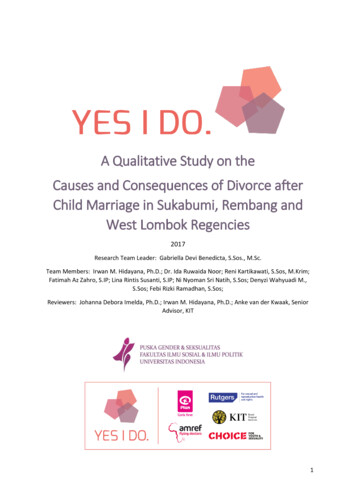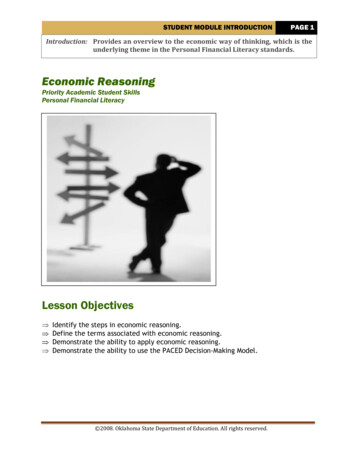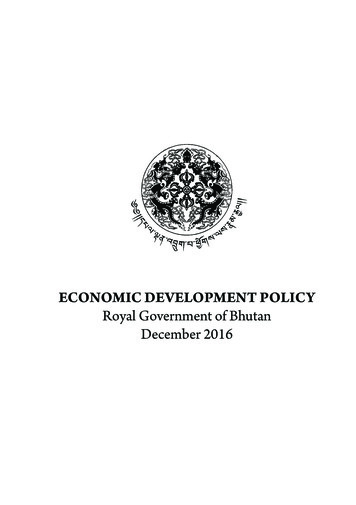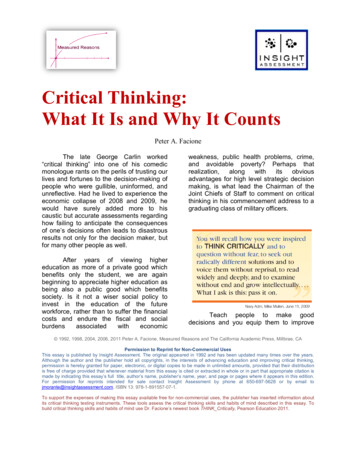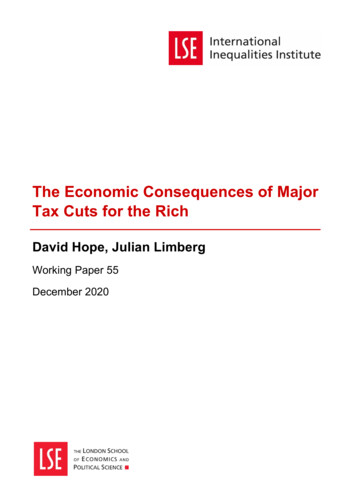
Transcription
The Economic Consequences of MajorTax Cuts for the RichDavid Hope, Julian LimbergWorking Paper 55December 2020
III Working Paper 55Hope, LimbergLSE International Inequalities InstituteThe International Inequalities Institute (III) based at the London School of Economics andPolitical Science (LSE) aims to be the world’s leading centre for interdisciplinary research oninequalities and create real impact through policy solutions that tackle the issue. The Instituteprovides a genuinely interdisciplinary forum unlike any other, bringing together expertise fromacross the School and drawing on the thinking of experts from every continent across theglobe to produce high quality research and innovation in the field of inequalities.In addition to our working papers series all these publications are available to download freefrom our website: www.lse.ac.uk/IIIFor further information on the work of the Institute, please contact the Institute Manager, LizaRyan at e.ryan@lse.ac.ukInternational Inequalities InstituteThe London School of Economics and Political ScienceHoughton StreetLondonWC2A 2AEEmail: Inequalities.institute@lse.ac.ukWeb site: www.lse.ac.uk/III@LSEInequalities David Hope and Julian Limberg. All rights reserved.2
III Working Paper 55Hope, LimbergAbstractThis paper uses data from 18 OECD countries over the last five decades to estimate thecausal effect of major tax cuts for the rich on income inequality, economic growth, and unemployment. First, we use a new encompassing measure of taxes on the rich to identify instances of major reductions in tax progressivity. Then, we look at the causal effect of theseepisodes on economic outcomes by applying a nonparametric generalization of the difference-in-differences indicator that implements Mahalanobis matching in panel data analysis.We find that major reforms reducing taxes on the rich lead to higher income inequality asmeasured by the top 1% share of pre-tax national income. The effect remains stable in themedium term. In contrast, such reforms do not have any significant effect on economic growthand unemployment.Keywords: Tax cuts for the rich, income inequality, growth, unemployment, difference-indifferences, Mahalanobis matching3
III Working Paper 55Hope, Limberg1. IntroductionRecent years have seen a resurgence in academic research on income inequality, driven bythe influential body of work by Piketty and co-authors charting the evolution of top incomesin the advanced economies over the course of the 20th century (Alvaredo et al., 2013;Atkinson et al., 2011; Piketty, 2014). A central finding from that literature is that while topincomes fell for several decades after the Second World War, they turned a corner and beganrising, most dramatically in the Anglo–Saxon economies, from the 1980s onwards (Alvaredoet al., 2013; Atkinson and Piketty, 2007). Correlational evidence from cross-country panelstudies has found that lower taxes on the rich, especially top marginal income tax rates, arestrongly associated with rising top incomes over this period (Huber et al., 2019; Piketty et al.,2014; Roine et al., 2009; Volscho and Kelly, 2012). Although, studies exploring the effects ofindividual tax reforms paint a less clear picture, with some finding persistent effects on incomeinequality (Rubolino and Waldenström, 2020) and others only short-term effects (Saez,2017).Proponents of tax cuts for the rich often argue for their beneficial effects on economicperformance. In fact, this line of reasoning, focusing on efficiency gains and the reduction ofbehavioural distortions, was central to the arguments made for major tax reforms in the US(Auerbach and Slemrod, 1997; Bartels, 2005; Gale and Samwick, 2017). There are fewempirical studies exploring the relationship between taxes on the rich and economicperformance, however, and the evidence we do have is mixed. While some cross-countryempirical studies find higher top marginal income tax rates and tax progressivity adverselyaffect economic growth (Gemmell et al., 2014; Padovano and Galli, 2002), a number of otherstudies find no significant association (Angelopoulos et al., 2007; Lee and Gordon, 2005;Piketty et al., 2014).Given the lack of consensus in existing studies and the difficulties of drawing causalconclusions from macro-level panel data analyses, it remains an open empirical questionhow cutting taxes on the rich affects economic outcomes. In this paper, we use data from 18OECD countries covering the last fifty years to investigate the effects of major tax cuts for therich on income inequality, economic growth, and unemployment. We contribute to the existingempirical literature in two ways: first, we use a newly constructed, comprehensive measureof taxes on the rich to identify years in which major tax cuts occurred across a wide range ofadvanced economies; and second, we move beyond correlational evidence on the economic4
III Working Paper 55Hope, Limbergeffects of taxing the rich by applying a novel matching method that allows for the estimationof causal effects from time-series cross-sectional data.Our approach to identify major tax cuts utilises a newly constructed indicator of taxes on therich (Hope and Limberg, 2020). The indicator was developed using Bayesian latent variableanalyses covering a wide range of taxes and indicators, which allows for the comparison oftaxes on the rich across countries and over time. We code major tax cuts as years in whichthe index fell by over 2 standard deviations. Across our sample of 18 OECD countries from1965 to 2015, this provides us with 30 country-year observations where taxes on the richwere significantly reduced.Our empirical identification strategy relies on our binary variable for major tax cuts for therich, which permits us to apply a nonparametric generalization of the difference-in-differencesindicator for panel data analysis (Imai et al., 2020). The technique uses Mahalanobismatching to compare treated and untreated units that have similar treatment histories andpre-treatment covariate trajectories. Furthermore, the methodology allows for explicit checksof covariate balance. We use this approach to estimate the causal effect of major reductionsin taxes on the rich on income inequality, economic growth and unemployment. We obtainestimates of the cumulative effects for up to half a decade after the reform, so can also assessthe extent to which effects persist over time.Our results show that, for both matching methods, major tax cuts for the rich increase the top1% share of pre-tax national income in the years following the reform (𝑡 1 to 𝑡 5). Themagnitude of the effect is sizeable; on average, each major reform leads to a rise in top 1%share of pre-tax national income of 0.8 percentage points. The results also show thateconomic performance, as measured by real GDP per capita and the unemployment rate, isnot significantly affected by major tax cuts for the rich. The estimated effects for thesevariables are statistically indistinguishable from zero, and this finding holds in both the shortand medium run.Our findings align closely with the existing correlational evidence showing that tax cuts forthe rich are associated with rising top income shares (Atkinson and Leigh, 2013; Huber et al.,2019; Piketty et al., 2014; Roine et al., 2009; Volscho and Kelly, 2012). We make an importantcontribution to this literature, however, as our empirical strategy allows for the estimation ofcausal effects. This is particularly pertinent in this case, as there is a large political scienceliterature on the power of rich voters and organised business interests to shape public policies5
III Working Paper 55Hope, Limberg(incl. tax policies) in their favour (Bartels, 2009; Emmenegger and Marx, 2019; Gilens, 2005;Hacker and Pierson, 2010; Svallfors, 2016), which suggests reverse causality could be amajor issue in empirical studies lacking a clear identification strategy.Existing causal evidence is limited to one study. Rubolino and Waldenström (2020) utilise thesynthetic control method and find that three major reductions in top marginal income tax ratesin Australia, New Zealand, and Norway had lasting and large positive effects on top incomeshares. We build upon this study by identifying major reductions in tax progressivity using amore comprehensive measure of taxes on the rich that goes beyond income tax progressivity.We also look at all major reductions in taxes on the rich across 18 advanced economies from1965 to 2015, which allows us to draw stronger and more generalizable conclusions.Our findings on the effects of growth and unemployment provide evidence against supplyside theories that suggest lower taxes on the rich will induce labour supply responses fromhigh-income individuals (more hours of work, more effort etc.) that boost economic activity(see standard models of optimal labour income taxation in Piketty and Saez, 2013 and Saez,2001). They are, in fact, more in line with recent empirical research showing that income taxholidays and windfall gains do not lead individuals to significantly alter the amount they work(Akee et al., 2010; Jones and Marinescu, 2018; Martinez et al., 2018).Overall, our analysis finds strong evidence that cutting taxes on the rich increases incomeinequality but has no effect on growth or unemployment. We do not directly test mechanismsin our analysis, but using a measure of top 1% share of pre-tax national income that includesboth labour and capital income makes it less likely that tax shifting and avoidance are drivingthe results. Our results are in line with those in Piketty et al. (2014), which suggest that lowertaxes on the rich encourage high earners to bargain more forcefully to increase their owncompensation, at the direct expense of those lower down the income distribution.The remainder of the paper proceeds as follows. Section 2 sets out our approach foridentifying major tax cuts for the rich and presents a visualisation of the resulting binaryvariable. Section 3 presents the data, empirical strategy, and results for our analysis of theeffects of major tax cuts for the rich on income inequality. We turn our attention to the effectson growth and unemployment in Section 4, before carrying out a series of robustness testsin Section 5. Finally, Section 6 provides some concluding remarks.6
III Working Paper 55Hope, Limberg2. Identifying major tax cuts for the richMany empirical studies look at single tax policy indicators to identify tax cuts for the rich.However, there is some disagreement on measuring taxes on the rich in the literature. First,there is no consensus on which taxes to look at. Whilst some authors look at taxes onpersonal income (Egger et al., 2019; Rubolino and Waldenström, 2020), others focus oncorporate taxation (Devereux et al., 2002) or inheritance taxation (Piketty and Saez, 2013b).Second, economists have used different tax policy indicators. Some look at top marginalincome tax rates (Piketty et al., 2014), while others look at effective tax rates (Egger et al.,2019) or revenue generation (Baunsgaard and Keen, 2010). We propose an encompassingapproach that utilises Bayesian latent variable analysis on a range of different taxes andindicators to overcome these problems. This allows us to detect shared variance across 7indicators that are commonly used proxies for taxes on the rich (see Table A1 in theAppendix). In total, the data cover 18 OECD democracies over 5 decades (1965-2015). Weestimate the latent variable using a Bayesian Markov-Chain Monte Carlo (MCMC) approachwith diffuse normal priors, three MCMC chains and 1000 burnin iterations (for moreinformation on the estimation of the latent variable, see Hope and Limberg, 2020).Figure 1 shows the development of the taxing the rich indicator in the sample.1 In line withother empirical studies that have found substantially declining taxes on the rich in the lastdecades (Egger et al., 2019; Scheve and Stasavage, 2016), the indicator decreasessubstantially from the mid-1980s onwards. From the late 1960s to the end of the 1990s, theaverage value of the latent variable for taxes on the rich across the sample dropped by morethan 30%. Furthermore, the cross-sectional standard deviation of the indicator steadilydeclined from the late 1960s. This indicates that tax policies on the rich have convergedamong OECD countries over time.1See Figure A1 in the Appendix for country-specific time series.7
III Working Paper 55Hope, LimbergFigure 1. Latent variable for taxes on the rich, 18 OECD countries, 1965-2015Source: Authors’ calculations; Hope and Limberg (2020).In a second step, we use the latent variable to detect major tax cuts for the rich. We calculatecountry-specific first-differences of the indicator and define major tax cuts as years in whichthe indicator drops by at least 2 standard deviations. Since we are interested in the effects ofmajor tax cuts for the rich, this high threshold is in line with our theoretical focus. Furthermore,two standard deviation shocks are often employed in the empirical literature inmacroeconomics (Dell’ Erba et al., 2015; Fernández-Villaverde et al., 2015) and this sizethreshold is in line with the size of tax and spending changes identified in the literatureexploring the effects of large fiscal policy adjustments on economic outcomes (Alesina andArdagna, 2010; Blanchard and Perotti, 2002).Figure 2 visualises the resulting binary variable that picks out years in which taxes on the richwere reduced substantially.2 In total, we identify 30 country-year observations where taxeson the rich were significantly reduced. Governments enacted major tax reforms in allcountries in our sample and across the whole observation period. Many countriesimplemented major tax cuts for the rich in the late 1980s. Furthermore, the identification of2Figure A2 in the Appendix shows how changes in the latent variable translate into the binary variable of majortax cuts based on the 2 standard deviations threshold.8
III Working Paper 55Hope, Limbergtax cuts is also in line with previous studies that have focused on income tax progressivity(Rubolino and Waldenström, 2020) or on overall tax progressivity single specific countries(Saez and Zucman, 2019). For instance, echoing these authors’ findings, we find two majorreforms that reduced taxes on the rich in the US: 1982 (First Reagan Tax Cut) and 1986/1987(Second Reagan Tax Cut).Figure 2. Distribution of major tax cuts for the rich, 1965-2015United StatesUnited KingdomSwedenNew ndFranceSource: Authors’ calculations.3. The effect on income inequality of major tax cuts for the richOur empirical design leverages variation in tax reform timings to estimate effects of cuttingtaxes on the rich on income inequality. Let us consider classical approaches of estimatingcausal effects for time-series cross-sectional data with 𝑁 countries and 𝑇 years. Up to date,most analysis of panel data rely on linear regression techniques with two-way fixed effectsand control variables. Such models typically take the following form:4𝑌* 𝛼* γ 𝛽1 𝑋* (𝛽3 𝑋3* ) 𝜀* 3569(1)
III Working Paper 55Hope, Limbergfor 𝑖 1, , 𝑁 and 𝑡 1, , 𝑇 and where 𝑌* denotes our main outcome variable and incountry 𝑖 and year 𝑡 and 𝛽1 is the estimated effect of the binary variable 𝑋* , which measuresmajor tax cuts for the rich. 𝛼* is the unobserved time-invariant country-specific effect and γ is the unobserved year-specific effect.4356(𝛽3 𝑋3* )denotes a set of 𝐾 time-varyingcovariates and 𝜀* is the error term. Using such an approach to estimate the causal impact ofmajor tax reforms that cut taxes on the rich on income inequality creates three methodologicalchallenges. First, the effect of reforms might vary over time. However, Equation 1 requiresthe researcher to specify a lag of the treatment registration. For instance, Equation 1 wouldestimate the contemporaneous reform effect (𝑡 0). Second, related to this, the standardapproach does not account for previous reform trajectories. Put differently, if 𝛽1 0 for 𝑋*, ? ,where 𝑛 ℕ, estimating the effect of tax reforms might run danger of being biased due toprevious reform trajectories (Rubolino and Waldenström, 2020). Thus, we need to comparecases with similar reform trajectories. Third, reforms do not come at random. Instead, politicaland economic factors might make reforms more likely, and these factors can also affectsubsequent income inequality dynamics. Furthermore, the practice of adding potentialconfounders as covariates like in Equation 1 does not allow for the assessment of covariatebalance.To deal with these challenges to causal identification, we use a new econometric approachthat implements a nonparametric generalisation of the difference-in-differences indicator forpanel data analysis (Imai et al., 2020). This technique compares units with a major tax reformin a respective year (treated units) with units that have a similar pre-treatment trajectory oftax reforms but have not enacted a tax cut in the same year (control units). Furthermore, themethod allows us to estimate how the treatment effects evolves over time. Most importantly,Imai et al. (2020) introduce 𝐹, which denotes the number of years after a tax reform, and 𝐿,which denotes the amount of lags prior to the treatment. Specifying 𝐹 allows the researcherto estimate varying treatment effects over time. For instance, setting 𝐹 5 measures thecumulative treatment effect for 5 years after a major tax cut for the rich. In contrast, 𝐿 allowsthe researcher to adjust for treatment histories, e.g. 𝐿 5 adjusts for the treatment history up5 years prior to the treatment. As a consequence, the average treatment effect on the treated(ATT) takes the following form,10
III Working Paper 55Hope, LimbergH𝛿 𝐹, 𝐿 𝔼 𝑌*, EF 𝑋* 1, 𝑋*, 6 0,𝑋*, ℓℓ5IH 𝑌*, EF 𝑋* 0, 𝑋*, 6 0,(2)𝑋*, ℓ 𝑋* 1, 𝑋*, 6 0ℓ5Iwhere countries that experience a major tax cut in year 𝑡 are the treated unit, hence 𝑋* 1as well as 𝑋*, 6 0. Hence, 𝑌*, EF 𝑋* 1, 𝑋*, 6 0,Hℓ5I 𝑋*, ℓis the potential outcome forcountries that have enacted a major tax cut and 𝑌*, EF 𝑋* 0, 𝑋*, 6 0,Hℓ5I 𝑋*, ℓis thecounterfactual potential outcome. We are interested in the cumulative effect up to 𝐹 yearsafter a tax reform and adjust for treatment histories up to 𝐿 years prior to a tax reform.Unfortunately, the counterfactual outcome for treated countries, i.e. 𝑌*, EF 𝑋* 0, 𝑋*, 6 0, 𝑋*, ℓHℓ5I 𝑋* 1, 𝑋*, 6 0, cannot directly be observed. Thus, we have to takepotential outcome for countries without a major tax cut for the rich instead.H𝛿 𝐹, 𝐿 𝔼 𝑌*, EF 𝑋* 1, 𝑋*, 6 0,𝑋*, ℓ 𝑋* 1, 𝑋*, 6ℓ5IH 0 𝑌*, EF 𝑋* 0, 𝑋*, 6 0,𝑋*, ℓ 𝑋* 0, 𝑋*, 6 0(3)ℓ5IHowever, tax cuts are not random. In particular, observed confounders,4356(𝑋3* ),as wellas unobserved confounders can lead to biased results. Thus, we use a difference-indifferences estimator as well as nonparametric matching techniques for additional timevarying covariates (Imai et al., 2020 p. 14). Matching is an intuitive and powerful tool to dealwith selection into treatment (Diamond and Sekhon, 2012; Ho et al., 2007). In contrast toadding confounders as covariates like in Equation 1, it is less prone to modelling decisionsand allows for the assessment of covariate balance. Furthermore, the difference-indifferences estimator relaxes the unconfoundedness assumption, but crucially assumes aparallel trend in the outcome variable after adjusting via matching on the previous treatmenthistory,Hℓ5I 𝑋*, ℓ ,as well as on the covariate trajectory,Hℓ51to explicitly check whether the parallel trend assumption holds.114356(𝑋3*, ℓ ).Thus, we need
III Working Paper 55Hope, LimbergWe use the block-bootstrap procedure proposed by Imai et al. (2020) to calculate standarderrors. Following Otsu and Rai (2017) and Imbens and Rubin (2015), this approachcircumvents the inference problems caused by standard bootstrapping procedures formatching by calculating the weight that each observation gets in the matching procedure.This weight-variable is used as a conditioning factor and is not recomputed in thebootstrapping procedure (Imai et al., 2020, p. 20).Our main treatment variable is therefore the presence of a major tax cut for the rich. Thefirst dependent variable we look at is income inequality, as measured by the top 1% share ofpre-tax national income.3 This measure includes both labour and capital income. Data comefrom the World Inequality Database (Alvaredo et al., 2018) and are calculated fromadministrative tax sources using a common methodology, so allow for comparison over timeand across countries (Atkinson et al., 2011; Roine and Waldenström, 2015). Top incomeshares are also used in many existing studies looking at the relationship between taxes onthe rich and income inequality (Huber et al., 2019; Piketty et al., 2014; Roine et al., 2009;Rubolino and Waldenström, 2020; Volscho and Kelly, 2012). We start by estimating thecausal effect of major tax cuts for the rich on inequality while solely matching on the treatmenttrajectory. We match units based on a 5-year pre-treatment window (i.e. 𝐿 5). Only 1observation could not be matched to control units with a similar treatment trajectory (see also,Figure A3 in the Appendix). Figure 3 visualises the matching approach by looking at fourexemplary cases of major tax cuts and the matched-on control groups.3There are some missing data points for top income shares (less than 10% of cases). In these cases, we haveused an exponentially weighted 5-year moving averages interpolation procedure.12
III Working Paper 55Hope, LimbergFigure 3. Visualisation of the matching approach, using four major tax cuts asexamplesSource: Authors’ calculations.Figure 4 shows the treatment effect after matching on the previous treatment trajectory. Inorder to differentiate between short- and medium-term effects of tax cuts for the rich, we lookat the effects for up to 5 years after the reform (i.e. 𝐹 5). For each year, the graph displaysthe cumulative treatment effect and 95% confidence intervals. The results show that majortax cuts lead to a significant increase in inequality and that this effect becomes stronger withtime. Three years after the reform, the top 1% income share increases by almost 0.6percentage points in countries with a major tax cut. Over five years, tax reforms increase thetop 1% share of pre-tax national income by more than 0.8 percentage points. This effect ishighly statistically significant, with P 0.0001. Furthermore, the graph also shows a placebotest by estimating the effect of tax cuts in the years before the reform. These placebo modelstest whether there have been significant different trajectories of inequality development in the13
III Working Paper 55Hope, Limbergcountries with and without a major tax cut prior to the reform.4 The point estimates of theplacebo tests are close to zero and statistically insignificant. In other words, the findings showstrong support for the parallel trends assumption that underlies the difference-in-differencesestimator.Figure 4. Effect of major tax cuts for the rich on top 1% income shares after matchingon treatment trajectorySource: Authors’ calculations.In a second step, we match units with a similar treatment history and with similar covariatetrajectories. We match on a battery of time-varying covariates, covering economic factors,such as real GDP per capita (in 2011 US dollars), capital openness via the Chinn-Ito Index(Chinn and Ito, 2006), and trade openness (imports and exports as % of GDP), as well aspolitical factors like the vote share of leftist parties and government expenditure (as % ofGDP). Table A2 in the Appendix shows the different covariates and their data sources. Wechoose a matching approach that is based on the Mahalanobis distance as opposed topropensity score matching, as recent studies have found that the latter can be inefficient andcreate model dependency (King and Nielsen, 2019). Similar to the previous analysis, we4Since the model calculates the first differences in relation to the year before the tax reform (i.e. t-1), the effectis 0 for this year.14
III Working Paper 55Hope, Limbergmatch upon 5-year pre-treatment windows. Importantly, matching on pre-treatment valueshas the advantage that we do not have a problem with post-treatment bias.Unlike multivariate regression analysis, the matching approach allows us to assessimprovements in covariate balance. Figure 5 visualises the covariate balance by comparingstandardised mean differences of the covariates before and after matching on theMahalanobis distance. Before matching, several variables showed significant imbalance withstandardised mean differences beyond the commonly accepted threshold of 0.25(Rosenbaum and Rubin, 1985). After matching, the standardised mean differences no longerexceed this threshold.Figure 5. Standardised mean difference of covariates before and after matchingSource: Authors’ calculations.When rerunning the difference-in-differences model after matching on both pre-treatmenttreatment trajectories and covariate history, our results hold (Figure 6). Reforms that reducetaxes on the rich have a substantial short- and medium-term effect on the top 1% share ofpre-tax national income. On average, such reforms increase the top 1% income share bymore than 0.8 percentage points after 5 years. We run placebo tests by estimating the effectof major tax reforms on pre-treatment changes in inequality. In line with the previous findings,the parallel trend assumption holds. The point estimate for the time periods 4 and 5 years15
III Working Paper 55Hope, Limbergprior to the treatment are negative (around 0.2 percentage points), but fail to reachconventional levels of statistical significance.Figure 6. Effect of major tax cuts for the rich on top 1% income shares after matchingon treatment trajectory and covariatesSource: Authors’ calculations.4. The effect on economic growth and unemployment of major tax cutsfor the richLet us now turn to the effect of major tax cuts for the rich on economic growth andunemployment. First, we analyse whether such reforms boost growth by looking at the effecton real GDP per capita. In line with other studies, we look at logged real GDP per capita(Piketty et al., 2014; Rubolino and Waldenström, 2020). Again, we estimate the ATT by usinga nonparametric generalisation of the difference-in-differences estimator. Like in the previoussection, we match upon the treatment trajectory, as well as on an additional battery ofcovariates via the Mahalanobis distance. Models are matched upon 5-year pre-treatmentwindows and we look at the effects of up to 5 years after the tax reform. Again, we use theblock-bootstrap procedure designed by Imai et al. (2020) to calculate standard errors forTSCS matching.Figure 7 presents the results. The left panel shows the model without covariates. Theresults suggest that tax reforms do not lead to higher economic growth. The effect size of16
III Working Paper 55Hope, Limbergmajor tax cuts for the rich on real GDP per capita is close to zero and statistically insignificant.The findings are very similar when matching upon pre-treatment covariate trajectories (rightpanel). Major tax cuts for the rich do not lead to higher growth in either the short or mediumrun. Furthermore, we do not find any effect of tax cuts on pre-treatment changes. Thus, theparallel trend assumption holds. We also calculated the same model by replacing (log) realGDP per capita with the real GDP per capita growth rate. Again, we find no significant effectof tax reforms on changes in GDP per capita growth (see Figure A5 in the Appendix).Figure 7. Effect of major tax cuts for the rich on (log) real GDP per capita after matchingon treatment trajectory (left panel) and treatment trajectory and covariates (right panel)Source: Authors’ calculations.Let us now look at the effect of major tax cuts for the rich on unemployment. To ensure crossnational comparability, we use harmonised unemployment rates as provided by the OECD(2020a). Figure 8 shows the results. In general, we see more fluctuation in the estimates. Inthe years right after the tax reform, the point estimate becomes negative. In the medium term,the estimate becomes close to zero again. However, none of these estimates is significant atthe 0.05 level. Furthermore, we can see slight fluctuation in the development ofunemployment rates prior to the tax reform. Whilst the placebo estimate for the 𝑡 5 timeperiod is negative, yet statistically insignificant, unemployment grew slightly faster in the yearprior to the reform. However, these placebo tests do not show indications of a clear pre17
III Working Paper 55Hope, Limbergtreatment trend. In sum, although the results show very slight indications of a flash in the paneffect of tax cuts for the rich on unemployment, these findings are neither statisticallysignificant nor robust.Figure 8. Effect of major tax cuts for the rich on unemployment rates after matchingon treatment trajectory (left panel) and treatment trajectory and covariates (right panel)Source: Authors’ calculations.5. Robustness checksWe run several alternative specifications to check whether our results are robust. First, weapply a lower threshold of 1 standard deviation to detect major tax cuts for the rich. Using a1 standard deviation threshold means that we include tax cuts of smaller magnitude. Hence,it is a more conservative approach of testing the impact of tax cuts on economic outcomes.Figure 9 visualises the effects on inequality, economic development, and unemployment.5The findings hold when using this alternative threshold. Cutting taxes for the rich increasesthe top 1% share of pre-tax national in
taxes on the rich encourage high earners to bargain more forcefully to increase their own compensation, at the direct expense of those lower down the income distribution. The remainder of the paper proceeds as follows. Section 2 sets out our approach for identifying major tax cuts for the rich and presents a visualisation of the resulting .


